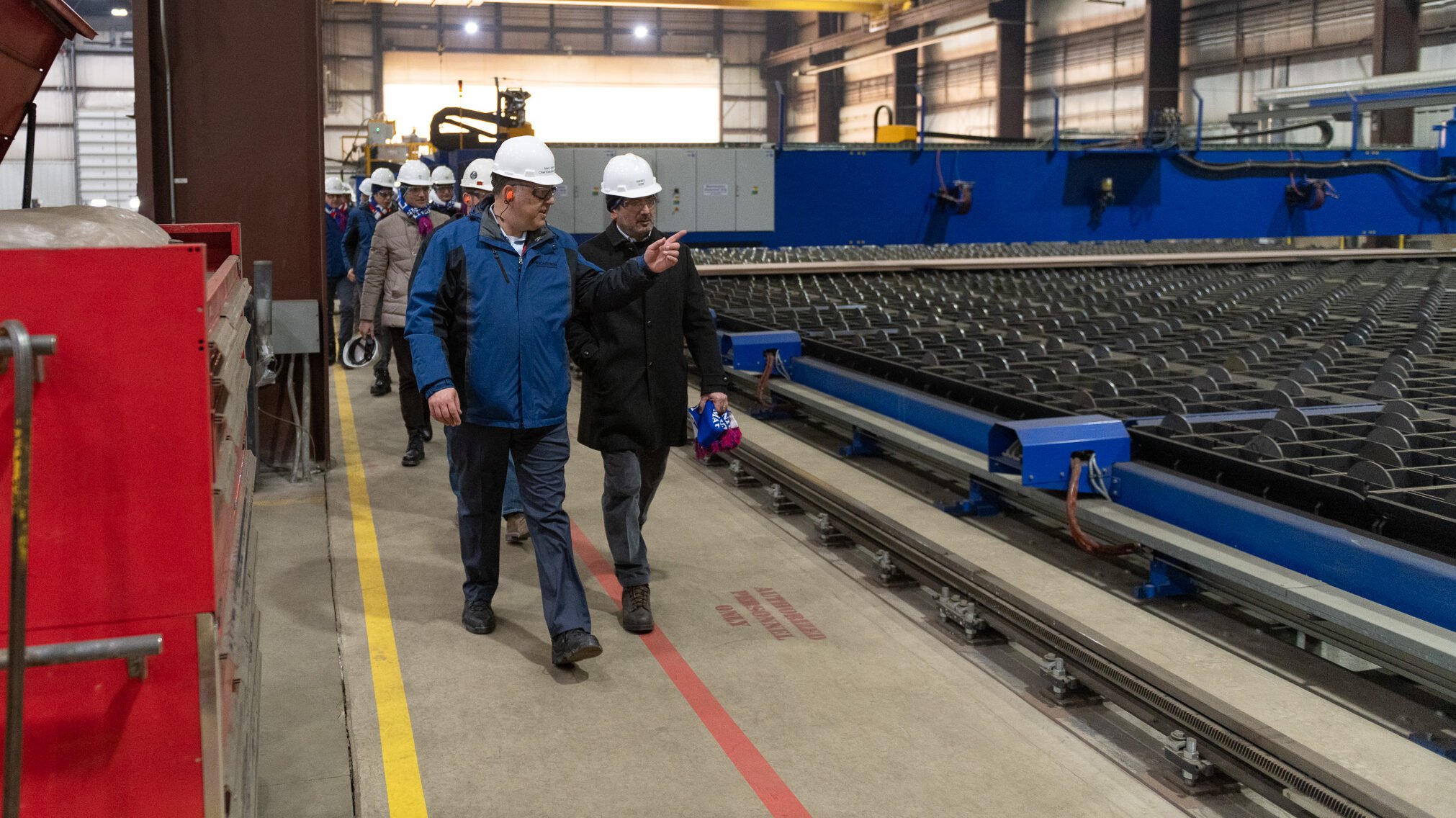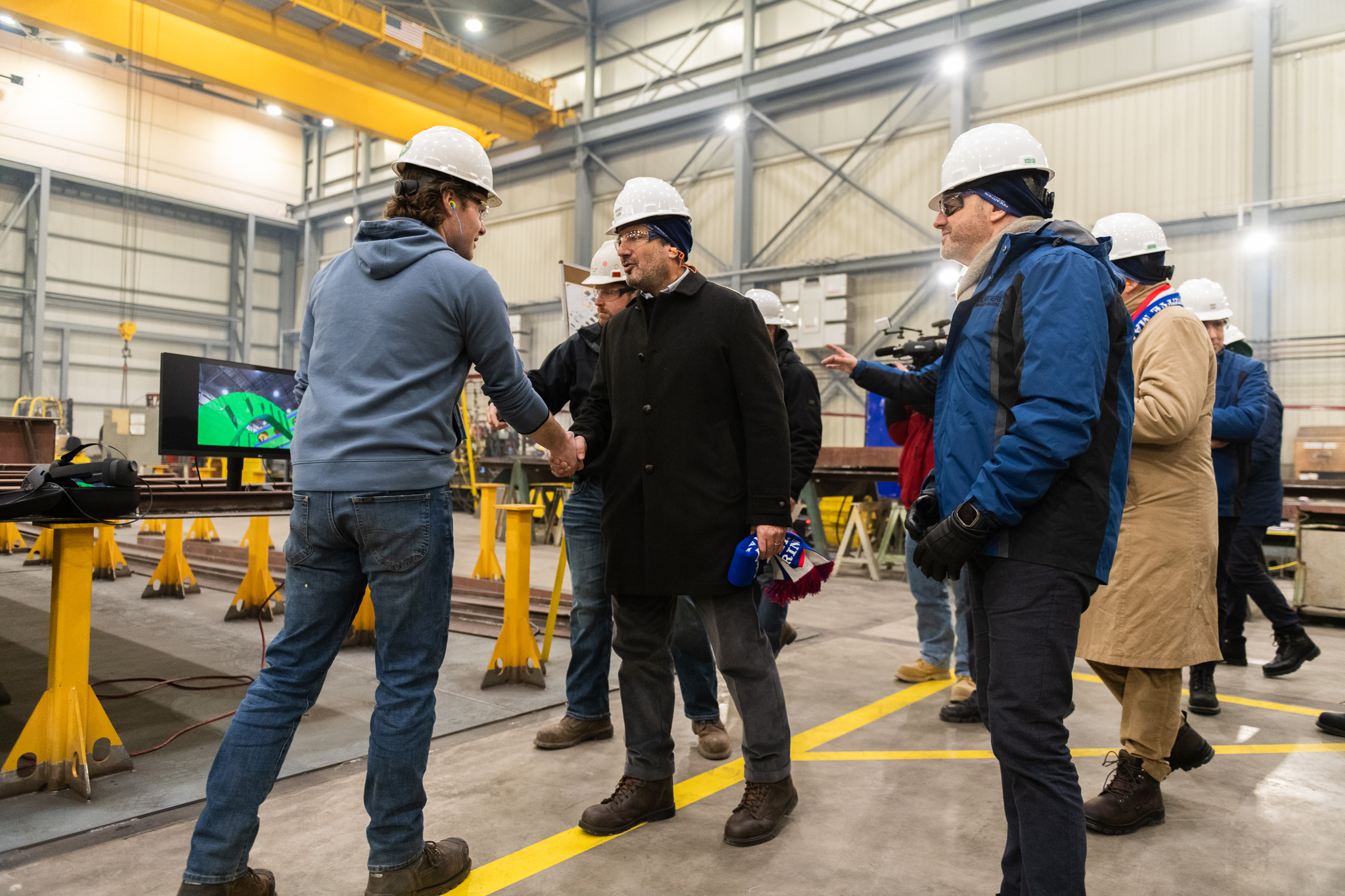
Pierroberto Folgiero, Fincantieri’s CEO, tours its Wisconsin shipyard. (Photo courtesy of Fincantieri Marinette Marine.)
WASHINGTON — After a week of touring the US and meeting with high-level US Navy brass, Fincantieri’s chief executive said the service’s messaging about building the new Constellation-class frigate is “very clear.”
“We perceive a lot of expectation from the US Navy,” Pierroberto Folgiero told Breaking Defense in an exclusive interview last week.
The service chose Fincantieri’s Wisconsin-based shipyard, Marinette Marine, in 2020 to design and build the new frigate based off the Italian FREMM. And with the troubled past of the Littoral Combat Ship as Constellation’s predecessor, lawmakers and Navy brass are certain to monitor the newer program’s progress closely.
But as one of the world’s largest shipbuilding companies, producing both commercial vessels and warships, Fincantieri’s portfolio stretches far beyond just a single US Navy frigate. In a wide-ranging interview, Folgiero — accompanied by Fincantieri chairman Claudio Graziano, a retired top Italian general who most recently served as Chairman of the European Union Military Committee discussed the impacts of the war in Ukraine, their stance on the possibility of a second shipyard building Constellation-class frigates and what regions of the world the company will target in the new year.
Ukraine Impact
Since the start of Russia’s war in Ukraine, defense budgets across Europe have steadily increased both in an effort to help the defending country and an effort to stabilize the continent’s security following one of the biggest conflicts its seen since World War II. But the early investments from those new Euros have gone primarily to land equipment, with a sprinkling of air assets in there. Does that mean naval contractors will be left out in the cold?
Graziano acknowledged that the new increases would not have a significant impact on shipbuilding in the near-future, largely because of the types of equipment being bought and the relatively small portion of budgets being devoted to helping Ukraine.
“It’s not the largest part of the budget,” he said. “It’s an immediate need to [fund] something that we don’t have at this moment… But the moment we are building that, I don’t think is depriving the Navy of the amount [of money] they need.”
Graziano noted the inherent long-term nature of shipbuilding and that spending $7 million on a tank compared to $1 billion on a warship is a “different mindset” for how you allocate the funding. as a result, while the focus short-term may go to tanks an artillery, “The navy in the future are going to gain, maybe, instead of losing.”
Folgiero, for his part, highlighted how naval ships are more “dual-use” than the military equipment being procured, and expressed his belief that could help justify increased spending on ships going forward.
“At the end of the day these big increases in budget have to be justified to taxpayers. And I believe that the navy has an [extra benefit] in this respect, because it is more versatile, because it can be used to defend commercial trade, because it is used to defend the energy infrastructure,” he said. “I believe the dual nature of navy increases the ‘salability’ of the extra expenditure on defense.”

Pierroberto Folgiero meets with workers at Fincantieri Marinette Marine. (Photo courtesy of Fincantieri Marinette Marine.)
‘A Lot Of Expectation’
Before Fincantieri’s bosses came to Washington, they spent some time at Marinette Marine, the company’s Wisconsin-based shipyard tasked with producing the US Navy’s new Constellation-class frigate.
Fincantieri beat out several other top defense contractors in 2020 to win the rights to design and build the ship that will succeed the Littoral Combat Ship. But from the starting line, the Navy has been eyeing the possibility of tapping a second shipyard to help build frigates. Fincantieri’s competitors, such as HII, have not been shy when asked to publicly comment on their interest in such a contract.
Predictably, Folgiero was not keen on the idea, insisting that everyone’s efforts right now should be focused on getting the lead ship perfect.
“I would say a prudent and knowledgeable owner would like to see validated and at-sea the first [frigate], so it would be a huge risk to go in parallel without having standardized, finalized, frozen and built the first of the class,” he said.
While Folgiero has obvious biases on the subject, the reality is that, at least publicly, Navy officials seem to agree with him. Whenever senior officers overseeing Constellation, such as Rear Adm. Casey Moton and Capt. Kevin Smith, are asked to comment on the issue, they too emphasize the need to get the lead ship right and not jump the gun on bringing in other shipbuilders.
The Inevitability Of Unmanned, Both In America And Abroad
There is growing interest in unmanned maritime vehicles, whether in the US or in places such as the UK, France and Sweden. Italy’s Fincantieri is no exception. The company’s Wisconsin shipyard is one of several contractors the US Navy tapped to conduct preliminary studies for the Large Unmanned Surface Vessel program.
Graziano, the company chairman and a former chief of staff for the Italian Armed Forces, said he’s confident unmanned systems will be part of the future for all militaries. Similar to artificial intelligence, he said, it “doesn’t matter if you like it or not… it is coming.”
But the process for any military to integrate more unmanned assets into operations will take time. When asked if he could see Fincantieri predominantly building unmanned systems in 15 years from now, he was quick to say that timeline is too short.
“When you think about [an aircraft like] the F-35… it was planned and researched and developed for 20 years. It’s still in production and is going to remain in production for 50 years,” he said. “The new development is going to be in the future, 20 [to] 30 years. To build an unmanned vessel corvette or frigate-sized, for sure you need 10 years for research and development at least.”
The Middle East Is A Top Hotspot For Growth
When asked about possible places for Fincantieri to grow this year, Folgiero first and foremost focused on the Middle East, noting the longstanding good political and diplomatic relations between Italy and the region.
“The natural market of a Southern European country like we are geopolitically and commercially is North Africa [and the] Middle East,” he said. “Then obviously, on top of Mediterranean there is the part of Europe that is close to Russia, in which the temperature is increasing, [such as] Romania [and] Bulgaria.”
He also said Southeast Asian countries such as Malaysia and Indonesia are of interest.
“We are in front of an investment cycle in which defense will be more than before,” he said. “And our offer is very much so that at the end of the day, frigates and corvettes are — if you are kind of a new Navy, that’s where you start from. You don’t start from carriers. You don’t start from submarines because it’s not for everyone.”
A Navy is a “versatile expense. You can defend trades and commerce, you can defend energy infrastructure, you can occupy the space in a very visible way,” he added.
Textron, Leonardo bank on M-346 global experience in looming race for Navy trainer
“The strength we think we bring is that [the Navy is] going to go from contract to actually starting to turn out students much quicker than any other competitors,” a Textron executive told Breaking Defense.



























